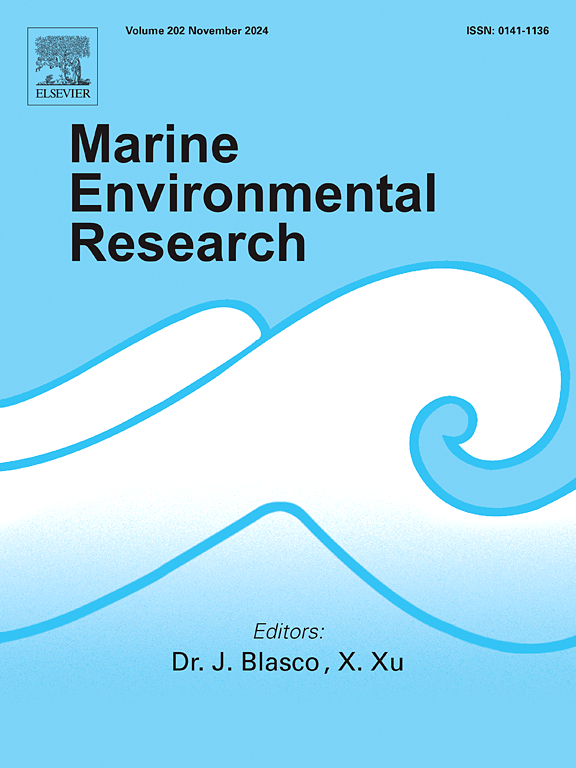Interannual health status stability of the reef-building coral Montastraea cavernosa in a Southwestern Atlantic marginal reef
IF 3
3区 环境科学与生态学
Q2 ENVIRONMENTAL SCIENCES
引用次数: 0
Abstract
Severe coral mortality after bleaching is well documented in the Indo-Pacific and Caribbean, but in the marginal Southwestern Atlantic, corals often exhibit lower post-bleaching mortality and high recovery following temperature anomalies. Understanding how these corals respond to environmental fluctuations can provide insights into their resilience against thermal stress. A seven-year assessment of the dominant reef-building coral Montastraea cavernosa was conducted in the oceanic archipelago of Fernando de Noronha, Southwestern Atlantic (3.86°S 32°42W), using a colony-based approach. We quantified healthy and bleached coral areas, colony area covered by algae, colony's border interactions with benthic organisms, and adjacent benthic cover during austral spring and relate eventual patterns with environmental drivers. Between 2013 and 2019, analyses of 43 colonies across three sites (totaling 167 observations) revealed that they largely remained healthy, with over 70 % of the area exhibiting a vivid dark color, and only small bleached areas (less than 1 %), despite a moderate-strong heatwave in 2018–2019. The adjacent algal cover fluctuated and was positively related to more turbid waters (higher sedimentation and organic matter input), but the monitored colonies were more contacted than expected by chance by algal turfs, a benthic group that does not impose a major competitive threat to corals. While it is unclear if corals bleached between sampling periods, the results suggest that reefs dominated by M. cavernosa may resist/recover thermal stress events, differing from the responses observed in the Indo-Pacific and Caribbean, highlighting the importance of including these marginal reefs in global assessments of coral responses to climate change.
西南大西洋边缘珊瑚礁造礁珊瑚的年际健康状况稳定性
在印度洋-太平洋和加勒比地区,漂白后严重的珊瑚死亡率得到了充分的记录,但在西南大西洋的边缘地区,珊瑚往往表现出较低的漂白后死亡率和温度异常后的高恢复率。了解这些珊瑚如何对环境波动做出反应,可以深入了解它们对热压力的恢复能力。在西南大西洋(3.86°S 32°42W)的Fernando de Noronha海洋群岛,使用基于种群的方法对主要的建礁珊瑚Montastraea cavernosa进行了为期7年的评估。我们量化了健康和漂白的珊瑚区,藻类覆盖的群落面积,群落与底栖生物的边界相互作用,以及南部春季附近的底栖生物覆盖,并将最终模式与环境驱动因素联系起来。在2013年至2019年期间,对三个地点的43个菌落(共167个观察结果)的分析显示,它们基本上保持健康,尽管2018-2019年出现了中等强烈的热浪,但超过70%的地区呈现出鲜艳的深色,只有一小部分漂白地区(不到1%)。邻近的藻类覆盖范围波动,与浑浊度更高的水域(更高的沉积和有机物输入)呈正相关,但监测的菌落与藻类草甸的接触比预期的要多,藻类草甸是一种底栖生物群,不会对珊瑚构成主要的竞争威胁。虽然尚不清楚珊瑚在采样期间是否会白化,但结果表明,与在印度-太平洋和加勒比地区观察到的反应不同,海绵状芽孢杆菌主导的珊瑚礁可能会抵抗/恢复热应激事件,这突出了将这些边缘珊瑚礁纳入珊瑚对气候变化反应的全球评估的重要性。
本文章由计算机程序翻译,如有差异,请以英文原文为准。
求助全文
约1分钟内获得全文
求助全文
来源期刊

Marine environmental research
环境科学-毒理学
CiteScore
5.90
自引率
3.00%
发文量
217
审稿时长
46 days
期刊介绍:
Marine Environmental Research publishes original research papers on chemical, physical, and biological interactions in the oceans and coastal waters. The journal serves as a forum for new information on biology, chemistry, and toxicology and syntheses that advance understanding of marine environmental processes.
Submission of multidisciplinary studies is encouraged. Studies that utilize experimental approaches to clarify the roles of anthropogenic and natural causes of changes in marine ecosystems are especially welcome, as are those studies that represent new developments of a theoretical or conceptual aspect of marine science. All papers published in this journal are reviewed by qualified peers prior to acceptance and publication. Examples of topics considered to be appropriate for the journal include, but are not limited to, the following:
– The extent, persistence, and consequences of change and the recovery from such change in natural marine systems
– The biochemical, physiological, and ecological consequences of contaminants to marine organisms and ecosystems
– The biogeochemistry of naturally occurring and anthropogenic substances
– Models that describe and predict the above processes
– Monitoring studies, to the extent that their results provide new information on functional processes
– Methodological papers describing improved quantitative techniques for the marine sciences.
 求助内容:
求助内容: 应助结果提醒方式:
应助结果提醒方式:


